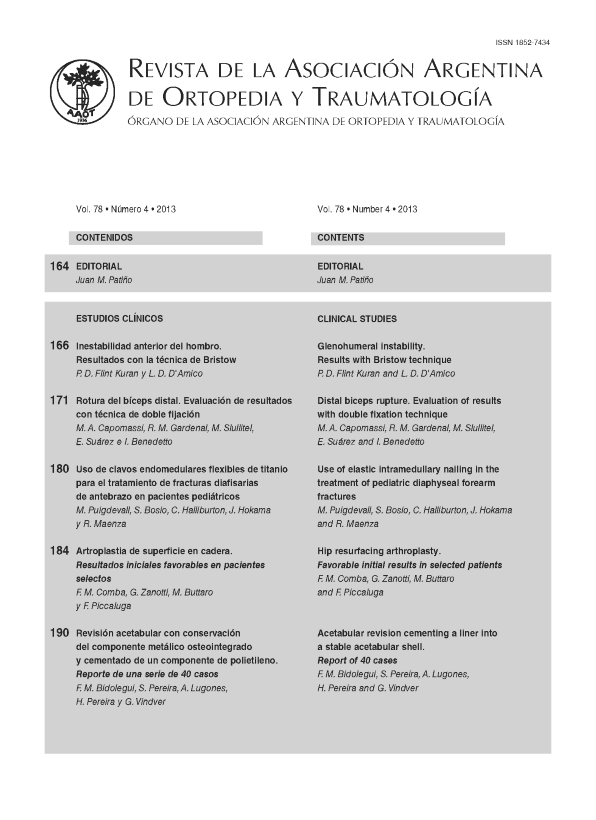Glenohumeral instability. results with bristow technique
Main Article Content
Abstract
Downloads
Metrics
Article Details

This work is licensed under a Creative Commons Attribution-NonCommercial-ShareAlike 4.0 International License.
Manuscript acceptance by the Journal implies the simultaneous non-submission to any other journal or publishing house. The RAAOT is under the Licencia Creative Commnos Atribución-NoComercial-Compartir Obras Derivadas Igual 4.0 Internacional (CC-BY-NC.SA 4.0) (http://creativecommons.org/licences/by-nc-sa/4.0/deed.es). Articles can be shared, copied, distributed, modified, altered, transformed into a derivative work, executed and publicly communicated, provided a) the authors and the original publication (Journal, Publisher and URL) are mentioned, b) they are not used for commercial purposes, c) the same terms of the license are maintained.
In the event that the manuscript is approved for its next publication, the authors retain the copyright and will assign to the journal the rights of publication, edition, reproduction, distribution, exhibition and communication at a national and international level in the different databases. data, repositories and portals.
It is hereby stated that the mentioned manuscript has not been published and that it is not being printed in any other national or foreign journal.
The authors hereby accept the necessary modifications, suggested by the reviewers, in order to adapt the manuscript to the style and publication rules of this Journal.
References
81.
2. Crespo M. La inestabilidad de hombro en el deporte. Rev Asoc Arg Ortop Traumatol 1993;58(4):488-93.
3. Moya D. Inestabilidades glenohumerales traumáticas. Rev Asoc Ortop Traumatol 1997;62(6):22-30.
4. Robinson M, Howes J, Murdoch H. Functional outcome and risk of recurrent instability after primary traumatic anterior
shoulder dislocation in young patients. J Bone Joint Surg 2006;88:2326-36.
5. Helfet AJ. Coracoid transplantation for recurring dislocation of the shoulder. J Bone Joint Surg Br 1958;40(2):98-202.
170 Flint Kuran y D’Amico Rev Asoc Argent Ortop Traumatol
6. Goutallier D, Allain J, Glorio C. Long term results of the Latarjet procedure for the treatment of anterior instability of the
shoulder. J Bone Joint Surg 1998;80:841-52.
7. Hovelius L, Korner L, Berg E. The coracoids transfer for recurrent dislocation of the shoulder. Technical aspect of the BristowLatarjet
procedure. J Bone Joint Surg 1983;65:926-34.
8.Torg JS, Balduini FC, Hensal FJ. A modified Bristow-Helfet-May procedure for recurrent dislocation and subluxation of the
shoulder. Report of two hundred and twelve cases. J Bone Joint Surg 1987;69:904-13.
9. Zuckerman JD, Matsen FA 3rd. Complications about the glenohumeral joint related to the use of screws and staples. J Bone
Joint Surg Am 1984;66:175-80.

